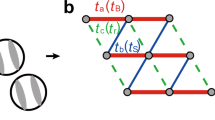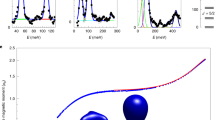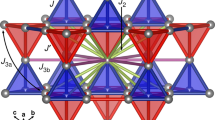Abstract
Molecular solids with cooperative electronic properties based purely on π electrons from carbon atoms offer a fertile ground in the search for exotic states of matter, including unconventional superconductivity and quantum magnetism. The field was ignited by reports of high-temperature superconductivity in materials obtained by the reaction of alkali metals with polyaromatic hydrocarbons, such as phenanthrene and picene, but the composition and structure of any compound in this family remained unknown. Here we isolate the binary caesium salts of phenanthrene, Cs(C14H10) and Cs2(C14H10), to show that they are multiorbital strongly correlated Mott insulators. Whereas Cs2(C14H10) is diamagnetic because of orbital polarization, Cs(C14H10) is a Heisenberg antiferromagnet with a gapped spin-liquid state that emerges from the coupled highly frustrated Δ-chain magnetic topology of the alternating-exchange spiral tubes of S = ½ (C14H10)•− radical anions. The absence of long-range magnetic order down to 1.8 K (T/J ≈ 0.02; J is the dominant exchange constant) renders the compound an excellent candidate for a spin-½ quantum-spin liquid (QSL) that arises purely from carbon π electrons.
This is a preview of subscription content, access via your institution
Access options
Access Nature and 54 other Nature Portfolio journals
Get Nature+, our best-value online-access subscription
$29.99 / 30 days
cancel any time
Subscribe to this journal
Receive 12 print issues and online access
$259.00 per year
only $21.58 per issue
Buy this article
- Purchase on SpringerLink
- Instant access to full article PDF
Prices may be subject to local taxes which are calculated during checkout






Similar content being viewed by others
References
Ramirez, A. P. Strongly geometrically frustrated magnets. Annu. Rev. Mater. Sci. 24, 453–480 (1994).
Balents, L. Spin liquids in frustrated magnets. Nature 464, 199–208 (2010).
Imai, T. & Lee, Y. S. Do quantum spin liquids exist? Phys. Today 69, 30–36 (2016).
Fu, M., Imai, T., Han, T.-H. & Lee, Y. S. Evidence for a gapped spin-liquid ground state in a Kagomé Heisenberg antiferromagnet. Science 350, 655–658 (2015).
Okamoto, Y., Yoshida, H. & Hiroi, Z. Vesignieite BaCu3V2O8(OH)2 as a candidate spin-½ Kagomé antiferromagnet. J. Phys. Soc. Jpn 78, 033701 (2009).
Shimizu, Y., Miyagawa, K., Kanoda, K., Maesato, M. & Saito, G. Spin liquid state in an organic Mott insulator with a triangular lattice. Phys. Rev. Lett. 91, 107001 (2003).
Itou, T., Oyamada, A., Maegawa, S., Tamura, M. & Kato, R. Spin-liquid state in an organic spin-½ system on a triangular lattice, EtMe3Sb[Pd(dmit)2]2 . J. Phys. Condens. Matter 19, 145247 (2007).
Isono, T. et al. Gapless quantum spin liquid in an organic spin-½ triangular-lattice κ−H3(Cat-EDT-TTF)2 . Phys. Rev. Lett. 112, 177201 (2014).
Saito, G. & Yoshida, Y. Development of conductive organic molecular assemblies: organic metals, superconductors, and exotic functional materials. Bull. Chem. Soc. Jpn 80, 1–137 (2007).
Takabayashi, Y. et al. The disorder-free non-BCS superconductor Cs3C60 emerges from an antiferromagnetic insulator parent state. Science 323, 1585–1590 (2009).
Ganin, A. Y. et al. Polymorphism control of superconductivity and magnetism in Cs3C60 close to the Mott transition. Nature 466, 221–225 (2010).
Zadik, R. H. et al. Optimized unconventional superconductivity in a molecular Jahn–Teller metal. Sci. Adv. 1, e1500059 (2015).
Ganin, A. Y. et al. Bulk superconductivity at 38 K in a molecular system. Nat. Mater. 7, 367–371 (2008).
Veciana, J. π-Electron Magnetism. From Molecules to Magnetic Materials (Springer, 2001).
Yamaguchi, H. et al. Unconventional magnetic and thermodynamic properties of S = ½ spin ladder with ferromagnetic legs. Phys. Rev. Lett. 110, 157205 (2013).
Riyadi, S. et al. Antiferromagnetic S = ½ spin chain driven by p-orbital ordering in CsO2 . Phys. Rev. Lett. 108, 217206 (2012).
Klanjšek, M. et al. Phonon-modulated magnetic interactions and spin Tomonaga–Luttinger liquid in the p-orbital antiferromagnet CsO2 . Phys. Rev. Lett. 115, 057205 (2015).
Mitsuhashi, R. et al. Superconductivity in alkali-metal-doped picene. Nature 464, 76–79 (2010).
Wang, X. F. et al. Superconductivity at 5 K in alkali-metal-doped phenanthrene. Nat. Commun. 2, 507 (2011).
Xue, M. et al. Superconductivity above 30 K in alkali-metal-doped hydrocarbon. Sci. Rep. 2, 389 (2012).
Kosugi, T. et al. First-principles electronic structure of solid picene. J. Phys. Soc. Jpn 78, 113704 (2009).
de Andres, P. L., Guijarro, A. & Vergés, J. A. Ab initio electronic and geometrical structures of tripotassium-intercalated phenanthrene. Phys. Rev. B 84, 144501 (2011).
Mahns, B., Roth, F. & Knupfer, M. Absence of photoemission from the Fermi level in potassium intercalated picene and coronene films: structure, polaron, or correlation physics? J. Chem. Phys. 136, 134503 (2012).
Ruff, A. et al. Absence of metallicity in K-doped picene: importance of electronic correlations. Phys. Rev. Lett. 110, 216403 (2013).
Naghavi, S. S. & Tosatti, E. Crystal structure search and electronic properties of alkali-doped phenanthrene and picene. Phys. Rev. B 90, 075143 (2014).
Heguri, S., Kobayashi, M. & Tanigaki, K. Questioning the existence of superconducting potassium doped phases for aromatic hydrocarbons. Phys. Rev. B 92, 014502 (2015).
Kubo, K. Excited states and the thermodynamics of a fully frustrated quantum spin chain. Phys. Rev. B 48, 10552–10555 (1993).
Kay, M. I., Okaya, Y. & Cox, D. E. A refinement of the structure of the room temperature phase of phenanthrene, C14H10, from X-ray and neutron diffraction data. Acta Cryst. B 27, 26–33 (1971).
Kato, T., Yoshizawa, K. & Hirao, K. Electron–phonon coupling in negatively charged acene- and phenanthrene-edge-type hydrocarbon crystals. J. Chem. Phys. 116, 3420–3429 (2002).
Kuzmany, H., Matus, M., Burger, B. & Winter, J. Raman scattering in C60 fullerenes and fullerides. Adv. Mater. 6, 731–745 (1994).
Kosaka, M. et al. Superconductivity in LixCsC60 fullerides. Phys. Rev. B 59, R6628–R6630 (1999).
Johnston, D. C. et al. Thermodynamics of spin S = ½ antiferromagnetic uniform and alternating-exchange Heisenberg chains. Phys. Rev. B 61, 9558–9606 (2000).
Oshikawa, M. & Affleck, I. Low-temperature electron spin resonance theory for half-integer spin antiferromagnetic chains. Phys. Rev. Lett. 82, 5136–5139 (1999).
Furuya, S. C. & Sato, M. Electron spin resonance in quasi-one-dimensional quantum antiferro-magnets: relevance of weak interchain interactions. J. Phys. Soc. Jpn 84, 033704 (2015).
Lemmens, P., Güntherodt, G. & Gros, C. Magnetic light scattering in low-dimensional quantum spin systems. Phys. Rep. 375, 1–103 (2003).
de’ Medici, L., Mravlje, J. & Georges, A. Janus-faced influence of Hund's rule coupling in strongly correlated materials. Phys. Rev. Lett. 107, 256401 (2011).
Nomura, Y., Nakamura, K. & Arita, R. Ab initio derivation of electronic low-energy models for C60 and aromatic compounds. Phys. Rev. B 85, 155452 (2012).
Nomura, Y. et al. Unified understanding of superconductivity and Mott transition in alkali-doped fullerides from first principles. Sci. Adv. 1, e1500568 (2015).
Werner, P. & Millis, A. J. High-spin to low-spin and orbital polarization transitions in multiorbital Mott systems. Phys. Rev. Lett. 99, 126405 (2007).
Smith, J. D. Organometallic compounds of the heavier alkali metals. Adv. Organomet. Chem. 43, 267–348 (1999).
Zabula, A. V. & Petrukhina, M. A. Structural perspective on aggregation of alkali metal ions with charged planar and curved carbon π-surfaces. Adv. Organomet. Chem. 61, 375–462 (2013).
Romero, F. D. et al. Redox-controlled potassium intercalation into two polyaromatic hydrocarbon solids. Nat. Chem. http://dx.doi.org/10.1038/nchem.2765 (2017).
Aidoudi, F. H. et al. An ionothermally prepared S = ½ vanadium oxyfluoride Kagomé lattice. Nat. Chem. 3, 801–806 (2011).
Balz, C. et al. Physical realization of a quantum spin liquid based on a complex frustration mechanism. Nat. Phys. 12, 942–949 (2016).
Altomare, A. et al. EXPO2013: a kit of tools for phasing crystal structures from powder data. J. Appl. Crystallogr. 46, 1231–1235 (2013).
Larson, A. C. & von Dreele, R. B. General Structure Analysis System (GSAS) (Los Alamos National Laboratory Report No. LAUR 86-748, 2000).
Perdew, J. P., Burke, K. & Ernzerhof, M. Generalized gradient approximation made simple. Phys. Rev. Lett. 77, 3865–3868 (1996).
Giannozzi, P. et al. QUANTUM ESPRESSO: a modular and open-source software project for quantum simulations of materials. J. Phys. Condens. Matter 21, 395502 (2009).
Vanderbilt, D. Soft self-consistent pseudopotentials in a generalized eigenvalue formalism. Phys. Rev. B 41, 7892(R)–7895(R) (1990).
Mostofi, A. A. et al. Wannier90: a tool for obtaining maximally-localised Wannier functions. Comput. Phys. Commun. 178, 685–699 (2008).
Nomura, Y., Sakai, S. & Arita, R. Multiorbital cluster dynamical mean-field theory with an improved continuous-time quantum Monte Carlo algorithm. Phys. Rev. B 89, 195146 (2014).
Bauer, B. et al. The ALPS project release 2.0: open source software for strongly correlated systems. J. Stat. Mech. Theor. Exp. P05001 (2011).
Acknowledgements
This work was sponsored by the World Premier International (WPI) Research Center Initiative for Atoms, Molecules and Materials, Ministry of Education, Culture, Sports, Science and Technology of Japan. We acknowledge financial support from the Japan Science and Technology Agency under the ERATO Isobe Degenerate π-Integration Project, the Mitsubishi Foundation, the Japan Society for the Promotion of Science (JSPS) under the Scientific Research on Innovative Areas ‘J-Physics’ Project (No. 15H05882), the European Union/JST SICORP-LEMSUPER FP7-NMP-2011-EU-Japan project (contract no. NMP3-SL-2011-283214), the UK Engineering and Physical Sciences Research Council (grant nos EP/K027255 and EP/K027212) and the Slovenian Research Agency (grant no. N1-0052). We thank the ESRF for access to synchrotron X-ray facilities, the Royal Society for a Newton International Fellowship (G.K.) and a Research Professorship (M.J.R.), A. N. Fitch for help with the synchrotron XRD experiments, H. Okazaki with the magnetic measurements and K. Kamarás with the infrared measurements.
Author information
Authors and Affiliations
Contributions
K.P. and M.J.R. conceived and designed the project. K.P. directed and coordinated the research. Y.T. and M.M. interpreted and discussed all the results and carried out the final structural and magnetic work. H.T., N.T., T.K., Y.N. and R.A. carried out the calculations. A.Š. synthesized the materials. D.A. carried out the EPR spectroscopy and G.K. the vibrational spectroscopic work. A.J.C.B. and A.Š. carried out early structural and magnetic work. K.P. wrote the paper with input from all the authors.
Corresponding authors
Ethics declarations
Competing interests
The authors declare no competing financial interests.
Supplementary information
Supplementary information
Supplementary information (PDF 2391 kb)
Rights and permissions
About this article
Cite this article
Takabayashi, Y., Menelaou, M., Tamura, H. et al. π-electron S = ½ quantum spin-liquid state in an ionic polyaromatic hydrocarbon. Nature Chem 9, 635–643 (2017). https://doi.org/10.1038/nchem.2764
Received:
Accepted:
Published:
Issue Date:
DOI: https://doi.org/10.1038/nchem.2764
This article is cited by
-
Redox-controlled potassium intercalation into two polyaromatic hydrocarbon solids
Nature Chemistry (2017)
-
Synthesis successes
Nature Chemistry (2017)



